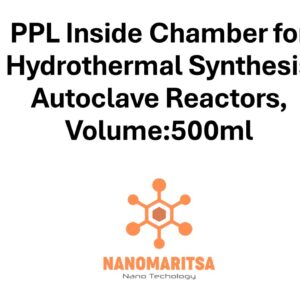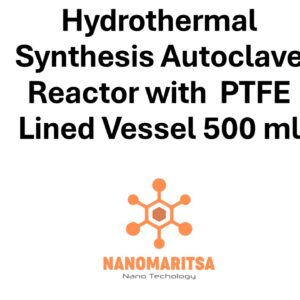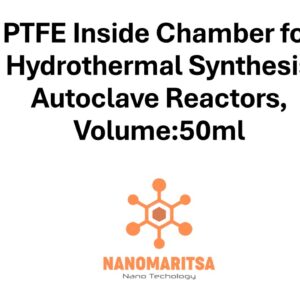LAB INSTRUMENTS & TOOLS
Hydrothermal Synthesis Autoclave Reactor with PTFE Lined Vessel 50 ml
€208.00
CompareHydrothermal Synthesis Autoclave Reactor with PTFE Lined Vessel (50 ml) is a specialized laboratory equipment used for conducting hydrothermal reactions under controlled conditions. Here’s an overview of its key features and uses:
- Key Features:
- Hydrothermal Synthesis: The reactor is designed to facilitate hydrothermal synthesis, a method of growing materials, such as nanoparticles, crystals, or advanced materials, in a high-temperature and high-pressure water-based environment. This process typically involves heating a solution or suspension within the reactor to promote chemical reactions that wouldn’t occur at lower temperatures or pressures.
- PTFE Lined Vessel: The vessel is lined with PTFE (polytetrafluoroethylene), a chemically inert and non-stick material. PTFE is highly resistant to corrosive chemicals and can withstand high temperatures, making it ideal for reactions involving acids, bases, or solvents that might damage other materials.
- Volume (50 ml): The reactor has a total volume of 50 milliliters (ml), meaning it is suitable for small-scale reactions. It is typically used for research, development, or synthesis of materials in laboratory settings, where small amounts of reagents are required.
- Pressure and Temperature Control: The reactor is capable of withstanding high-pressure and high-temperature conditions, essential for hydrothermal reactions. These conditions promote the formation of solid materials, crystals, or nanoparticles from solutes in the solution.
- Safety Features: Autoclave reactors are designed with safety features to handle the high pressures and temperatures involved in hydrothermal reactions. The PTFE lining also helps to contain hazardous materials within the reactor.
- Properties:
- Chemical Inertness: The PTFE lining ensures that the vessel remains chemically inert, preventing unwanted reactions between the reactor material and the reactants. This is especially important when dealing with reactive or corrosive chemicals.
- Temperature and Pressure Resistance: The reactor is built to withstand high temperatures (typically ranging from 150°C to 250°C) and high pressures, which are often required for hydrothermal synthesis to achieve desired material properties.
- Uniform Reaction Environment: The sealed environment allows for uniform heating, ensuring consistent reaction conditions for the growth of materials or crystals inside the reactor.
- Applications:
- Nanomaterial Synthesis: Hydrothermal autoclave reactors are often used in the synthesis of nanoparticles, nanomaterials, and other advanced materials for applications in electronics, energy storage, and catalysis.
- Crystal Growth: The reactor can be used to grow single crystals or polycrystals of various materials, including metal oxides, semiconductors, and other inorganic compounds, which are used in research and material science.
- Catalysis Research: Hydrothermal conditions can be applied in the synthesis of catalysts or catalytic materials, which are essential in chemical processes, energy conversion, and environmental applications.
- Environmental Remediation: The reactor can be used for research in environmental applications, such as the synthesis of materials for water purification, waste treatment, or CO2 capture.
- Synthesis of Advanced Ceramics: The hydrothermal method is often employed for producing ceramics, such as metal oxides, which are used in electronic devices, sensors, and coatings.
- Handling and Safety:
- Toxicity and Corrosiveness: While the PTFE lining ensures chemical resistance, care should be taken when working with toxic or corrosive substances inside the reactor. Always ensure that the materials used in the reaction are compatible with PTFE and the reactor’s pressure capabilities.
- Pressure and Temperature Safety: Hydrothermal reactors operate under high pressure and temperature, so proper safety protocols must be followed. The reactor should be used in accordance with the manufacturer’s specifications and safety guidelines.
- Storage and Maintenance: After use, the reactor should be cleaned thoroughly, especially if corrosive chemicals have been used. The PTFE lining should be inspected for damage, and the sealing mechanisms should be checked for any signs of wear to prevent leaks.
- Precautions: Always use appropriate personal protective equipment (PPE), such as gloves, goggles, and lab coats, when handling the reactor. Work in a well-ventilated area, preferably within a fume hood, to avoid inhaling vapors or fumes from the reaction.
This 50 ml Hydrothermal Synthesis Autoclave Reactor is ideal for small-scale, high-temperature and high-pressure reactions, particularly in material synthesis and nanotechnology research. Its PTFE-lined vessel ensures compatibility with a wide range of chemicals, while the controlled environment inside promotes the formation of advanced materials with precise properties.
| Pieces | 1 Piece, 5 Pieces |
|---|






